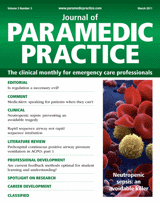References
An overview of the Medical Emergency Response Team (MERT) in Afghanistan: a paramedic's perspective
Abstract
This article gives an overview of the Medical Emergency Response Team (MERT) while deployed in Afghanistan during Operation Herrick. The article is an information piece giving a brief history, training background and an overview on how the MERT works and is governed. It will give an insight into the clinical procedures used by a multi-disciplinary pre-hospital care team, the decision-making process and the advances made in military pre-hospital care. It is written from a paramedic's perspective and develops the understanding of how MERT and wider military developments during this conflict have impacted on civilian trauma care and what potential it has in the future.
The Royal Air Force (RAF) has been providing forward aeromedical evacuation (FwdAE) in many conflicts in recent history. FwdAE is defined as providing care to patients within the battle space from point of injury (POI) to definitive care or intra conflict moves of patients (Air Publication 3394, 2009). During the Balkans conflict this was conducted on Naval Sea Kings and staffed with a single RAF medic and was known as Number 3 Casualty Evacuation Squadron (3 CASEVAC). More recently, during Operation (Op) Telic (Iraq) the Immediate Response Team (IRT) used Puma, Merlin or Chinook helicopters to evacuate patients and the medical team consisted of an RAF medic, RAF nurse and was supplemented by a medical officer (GP) if required.
In April 2006 British Forces deployed to Helmand province, Afghanistan to support the International Security Assistance Force (ISAF) mission. It is here that the Medical Emergency Response Team (MERT) was developed to effectively manage the high levels of trauma casualties. The MERT has now been operating from Camp Bastion for almost seven years, using the CH47 Chinook helicopter and a medical team consisting of one tri-service doctor (anaesthetist or emergency medicine), one RAF emergency nurse and two RAF paramedics. This is an RAF single service led asset, with a triservice clinical oversight that is provided by the defence consultant advisor in emergency medicine (DCA EM).
Subscribe to get full access to the Journal of Paramedic Practice
Thank you for visiting the Journal of Paramedic Practice and reading our archive of expert clinical content. If you would like to read more from the only journal dedicated to those working in emergency care, you can start your subscription today for just £48.
What's included
-
CPD Focus
-
Develop your career
-
Stay informed

